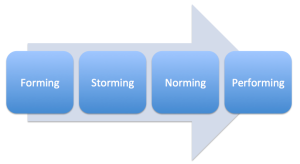Tuckman’s Stages of Group Development
Bruce Tuckman developed a model to explain the various stages a group will go through before getting to the desired optimal performing stage.
1. Forming Stage
When a team is first brought together there is confusion about what is required. Although keen to proceed there are no group roles. No one knows what is expected or who is required to do what. Communication starts – albeit typically superficially. Each protecting their own perspective/position, risking little. What is required is a clear goal, purpose and leadership. Who will do what, and when? The process of building effective relationships begins. Tuckman referred to this as the forming stage.
2. Storming Stage
During the storming phase members of the team start to connect – building relationships. We assert our position, find allies and look to create a niche for ourselves. Human behaviour being what it is, conflict soon arises as we seek to define our role within the group. If you are the leader, why should anyone follow you? Clear communication, focus on the purpose and goal of the group and individual support to team members will help to work through this phase.
3. Norming Stage
There is clearer clarity of what is expected and individual roles within the team – so focus moves to completing the task at hand. Pecking orders (roles and responsibilities) have been (initially at least) established, and now the team understands the rules under which the team will operate. The focus is now around processes, objectives, systems, action. This is the norming stage, and is often very productive. The leader’s role is to empower, keep focus, resolve team dynamic issues and stay strategic.
4. Performing Stage
Belonging to a performing team is exciting. The quality and depth of relationships means the group is a well oiled machine – and gathers momentum. New issues are resolved quickly as team members support each other, synergistically. Characteristics of such a team include performance against objectives, achieving results, flexibility, a collective spirit (“we” rather than “I”) with shared purpose, vision and behaviours. Leadership is focussed on maintaining this stage – looking for barriers to continued performance and engaging as necessary to ensure the team is not railroaded.
5. Adjourning or Mourning Stage
In 1977 a fifth stage was added – which they called Adjourning for want of a better rhyme. Belonging to a performing group is an incredible and often profound experience. We feel a deep sense of belonging, connectedness, achievement and purpose. It is no surprise then that when the group’s purpose ends, there is a period of grief. Often individuals will try to meet up regularly afterwards to try to recapture the sense of performing they experienced – and a lucky few go on to enjoy life long friendships as a result of this dynamic experience.
Tuckman’s Stages of Group Development Videos
Denzel Washington stars in the film ‘Remember the Titans – a highly motivational film depicting how a team moves through Tuckman’s Stages of Group Development
- A great montage of Tuckman’s Stages of Group Development – five stages (8:33)
- Another perspective on team building using the same film (5:41)
Two longer examples of the first two stages (Storming and Norming);
- Creation of team – Part 1 (Storming) – 10 minutes
- Creation of a team – Part 2 (Forming) – 10 minutes
- Alas the author didn’t go on and create the other parts, but the above are still excellent to highlight the behaviours associated with the first of Tuckman’s Stages of Team Development.
Questions for Reflection
- What behaviours are your team currently engaged in?
- What is your strategy to move through the stages?
- Is conflict a good or bad thing?
- Are your goals set clearly in order for the team to reach the perform stage?
- If you asked your team – where would they rate themselves?

